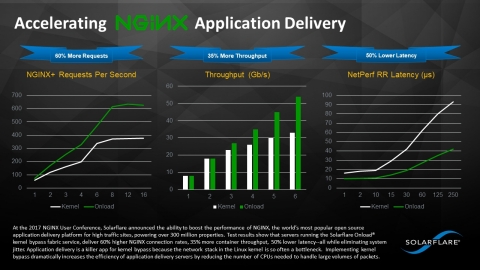PORTLAND, Ore.--(BUSINESS WIRE)--NGINX USER CONFERENCE — Solarflare, a pioneer in the development of software defined NICs, today announced its ability to boost the performance of NGINX, the world’s most popular open source application delivery platform for high traffic sites, powering over 300 million properties. Test results show that servers with standard XtremeScale™ NICs, deliver 60% higher NGINX connection rates, 35% more container throughput, 50% lower latency--all while eliminating system jitter. For NGINX service providers, that means more application delivery with less server capital. Solarflare will be demonstrating NGINX performance testing in the Solarflare booth at the NGINX User Conference.
"Service providers require their application delivery solution to offer the highest performance and efficiency to provide the best possible experience to their users," said Paul Oh, Head of Business Development at NGINX. "By utilizing Solarflare NICs with NGINX Plus, customers can benefit by enabling the same amount of packet processing to be done with far less cores and servers."
According to Ahmet Houssein, vice president of marketing at Solarflare, “Application delivery is a killer app for our software defined NICs because the network stack in the Linux kernel is so often a bottleneck. Implementing XtremeScale NICs dramatically increases the efficiency of application delivery servers by reducing the number of CPUs needed to handle large volumes of packets.”
The Business Benefit of Application Delivery with XtremeScale NICs
It’s simple. XtremeScale Fabrics allows IT organizations to deploy fewer NGNIX servers. NGNIX performance testing by Solarflare indicates most competitive 10Gb NIC implementations require about six cores to achieve 80% wire-rate. In contrast, a Solarflare XtremeScale NIC achieves 90% wire-rate performance utilizing only two cores. In this test case, two thirds less servers are needed for the same amount of work.
The Trend Towards Software Defined NICs
High frequency trading, web servers and load balancers are at the top of the performance pyramid because they handle millions of packets per second and need ultra-high bandwidth and ultra-low latency network connections. Looking forward, big data analytics is emerging fast as a foundation for a broad range of business applications. This massive new market is driving a pervasive need for high performance networks, and a corresponding trend towards NIC fabrics for granular, packet-level traffic engineering.
One problem these applications face is the networking stack inside every Linux distribution has a limit on how many packets per second it can manage. When the limit is reached, CPUs become busy receiving packets, packets are dropped, and applications are starved of CPU. In response, companies like Solarflare have pioneered a form of software defined networking where fabric services are placed alongside other applications in “user space” to bypass the kernel, while network engineers can access and control the kernel bypass application for each server through well defined APIs.
Solarflare XtremeScale Architecture, XtremeScale Fabric and Software Defined NICs
The NIC fabric hardware and software deployed by hyperscale cloud service providers is proprietary. Solarflare has developed an XtremeScale Fabric platform which provides server-level granularity and scalability and is now commercially available. The platform consists of:
XtremeScale Architecture—All new Solarflare chips, adapters and software are designed under an architecture designed for scalable and granular Ethernet traffic engineering.
XtremeScale Software Defined NICs—Join FPGAs and NPUs in the Smart NIC class of server adapters. The powerful, software defined products are the industry’s first NICs with FPGA-like capabilities at the cost of a NIC.
XtremeScale Fabric—Once XtremeScale NICs are installed, XtremeScale Fabric applications are available to provision performance, security and visibility applications tailored for specific workloads running on physical servers, VMs and container microservices. Universal Kernel Bypass (UKB), is a suite of kernel bypass fabric services for accelerating application performance. Onload is the UKB application proven in the electronic trading industry. DPDK and NVMe are the two newest UKB apps available for accelerating NFV and storage server traffic.
About NGINX, Inc.
NGINX is the heart of the modern web – helping the world’s most innovative companies deliver their sites and applications with performance, reliability, security, and scale. The company offers an award-winning, comprehensive application delivery platform in use on more than 300 million sites worldwide. Companies around the world rely on NGINX to ensure flawless digital experiences through features such as advanced load balancing, web and mobile acceleration, security controls, application monitoring, and management. More than half of the Internet’s busiest websites rely on NGINX, including Airbnb, Box, Instagram, Netflix, Pinterest, SoundCloud, and Zappos. The company is headquartered in San Francisco, with its EMEA headquarters in Cork, Ireland, and additional offices in the US and Europe. Learn more at https://www.nginx.com.
About Solarflare
Solarflare is pioneering server connectivity for neural-class networks. From silicon to firmware to software, Solarflare provides a comprehensive, integrated set of technologies for distributed, ultra-scale, software-defined datacenters.
The Solarflare XtremeScale Architecture is a design framework which includes a comprehensive suite of features for ultra-scale environments: High-bandwidth, ultra-low-latency, ultra-scale connectivity, software defined, secure with hardware firewalls, and instrumented for line-speed telemetry.
Solarflare solutions have earned a sterling reputation in financial services and are used by virtually every major global exchange, commercial bank and hedge fund. This exacting, regulated performance uniquely qualifies our solutions for use in ultra-scale applications in IoT, big data and artificial intelligence where low latency, robust security and insightful telemetrics are critical.
Solarflare solutions are available from leading distributors and value-added resellers, as well as from major global manufacturers. Solarflare is headquartered in Irvine, California, and operates R&D facilities in Cambridge, UK and New Delhi, India.




